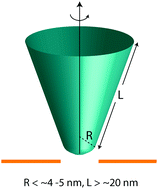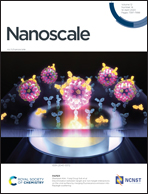Pore formation induced by nanoparticles binding to a lipid membrane†
Abstract
Nanoparticles (NPs) enter a cell primarily via endocytosis, during which they are engulfed by the cell and reside in lipid vesicles named endosomes. Apart from when an endosome is pinched off the plasma membrane, structural integrity of its lipid membrane is usually well maintained. Under certain circumstances, however, such structural integrity can be considerably perturbed by a nanoparticle. For instance, recent experiments [Chu et al., Sci. Rep., 2014, 4, 4495] indicate that nanodiamonds with sharp corners can escape from an endosome by piercing its lipid membrane. Nonetheless, the energetics of this behavior and how it may be controlled by membrane adhesion and NP morphology remain unclear. In this work, we employ continuum modeling to investigate membrane pore formation induced by the spontaneous binding of a sharp nanoparticle. Based on two axial-symmetric NP models, we characterize the indispensable role played by curvature heterogeneity, membrane adhesion, and the sharpness as well as the size of a nanoparticle in ‘breaking’ a lipid membrane. Apart from revealing a general mechanism of NP binding-induced membrane pore formation, our results provide the reference for improving the endosomal escape of nanoparticles through manipulating their morphology, a direction that can be explored either independently or combined with existing strategies targeting NP surface chemistry.

- This article is part of the themed collection: Theoretical Modelling at Nano-bio Interfaces


 Please wait while we load your content...
Please wait while we load your content...